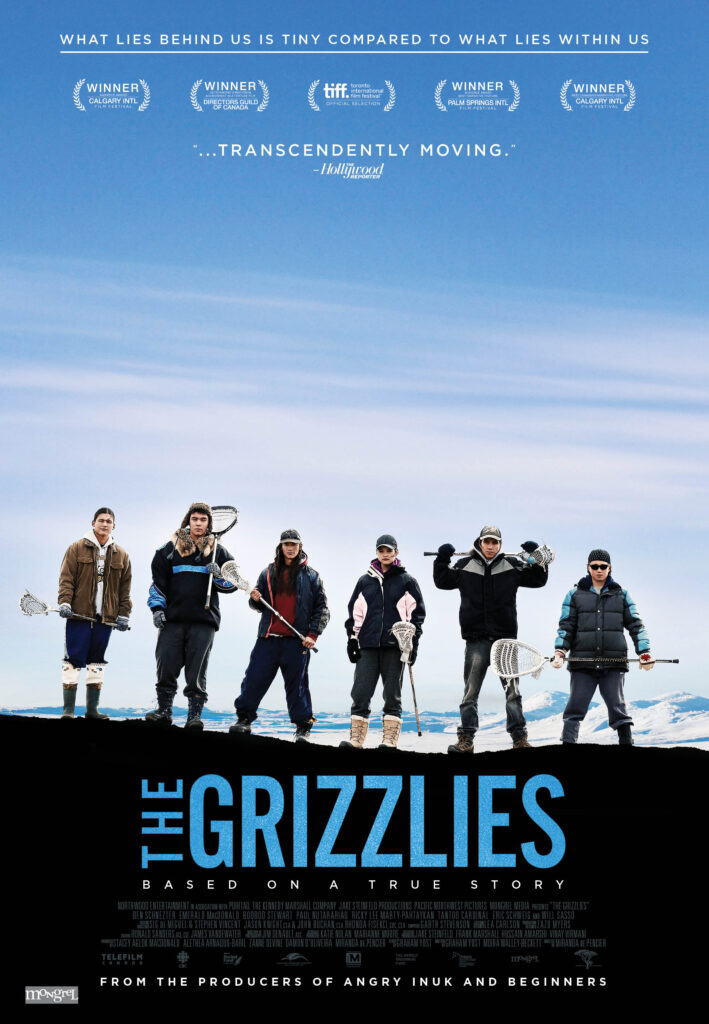

Welcome To
The James Museum from Home
Connect with us through curated content based on our collection. Explore art, movies, books, music, children’s activities and more. Each theme is freshly considered and developed by our curatorial and education teams. We invite you to discover a new way to experience the museum and learn more about our collection.
Theme: Winter
Selected Artwork
“Winter is not a season, it’s a celebration.” -Anamika Mishra
Winter brings longer nights, cooler air, and special holidays. We hope you stay warm while enjoying this selection of Winter-themed works of art.
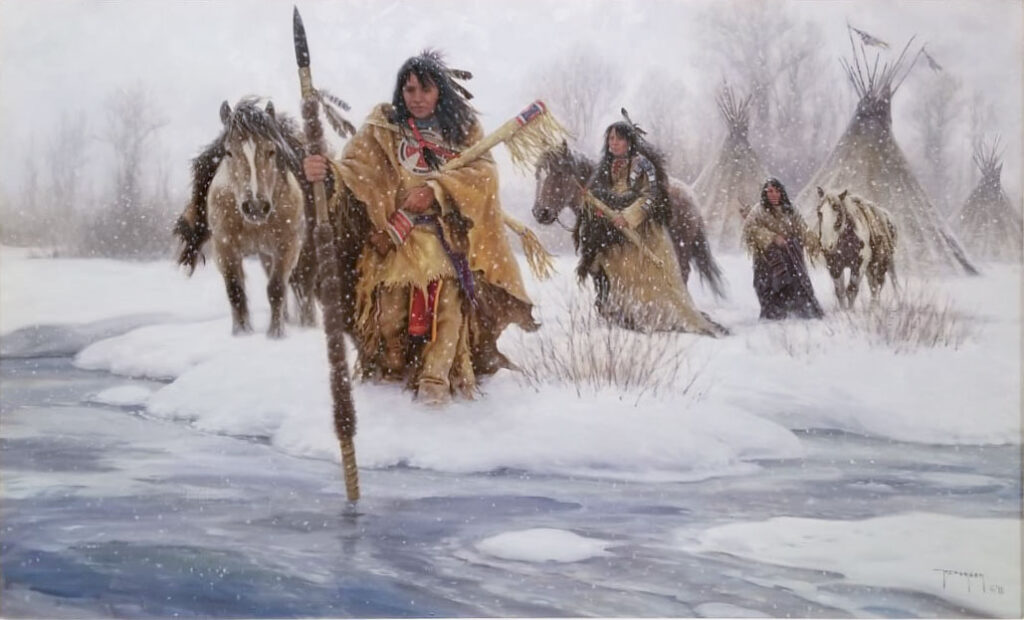
Robert Duncan
American, born 1952
Hard Times for Travel
2011
Oil on canvas
Art Spotlight
By: Caitlin Pendola | Curatorial Assistant
The first winter landscape was depicted in the art of Europe in the 16th century. Prior to this time, virtually all paintings were of religious subject matter. Nature was branded as something to fear and tame. Depicting such secular imagery would have been widely regarded as unfavorable and unproductive. With only a handful of exceptions, snow did not begin to appear regularly in European art until the 17th century, and even then was created only by Dutch artists. Not until the Romantic period (approximately 1800–1850) did winter landscapes become popular in their own right. Among other characteristics, this artistic movement emphasized the power of nature.
Immediately following Romanticism was the Realism movement, characterized by humble depictions of everyday life. Much of American Western art is influenced by Europe’s Romantic and Realism eras. Romanticism was at its peak in Europe when the painters of the Hudson River School were making their mark on American Western art. Realism was at its peak when the grandfathers of Western art, such as Frederic Remington and Charles Russell, were artistically coming-of-age.
In this painting titled Hard Times for Travel, artist Robert Duncan captures the imaginative, idyllic traits of Romanticism and overlaps it with the everyday life depictions of Realism. Three Northern Plains Indians walk through a snowy, winter landscape. Their clothing, made from the hide of mountain sheep, keeps them warm against the harsh climate. Where are they going? Probably not far because their camp is still assembled behind them.
Painting snow has unique challenges. The artist must capture the subtle variations in color; snow is not simply white. Here, Duncan uses cool hues of blues and grays to create an overcast, snowy day. Another challenge is creating visual interest. With so little color variation a painting could easily become bland. The artist avoids this by creating a strong contrast between the figures and the landscape surrounding them and by directing the viewer’s eye steadily across the canvas. This tonal balance and rhythm also lend itself to the tranquil mood of the scene.

Ray Vinella
Italian American, 1933–2019
Christmas Eve, Taos Pueblo
1986
Oil on canvas
Art Spotlight
By: Caitlin Pendola | Curatorial Assistant
Christmas Eve, Taos Pueblo by artist Ray Vinella stands out as slightly different from other works in the James Museum collection. Modest in size, it measures only 16 inches in width, and it is heavily Impressionistic. Because of this, it is possible Vinella produced the painting en plein air (outside) to express the immediacy and energy of the scene. The use of complementary colors to create loose shapes that flirt with abstraction also sets this piece apart from other paintings in the Native Life gallery.
In the background, we see the exterior of an adobe structure illuminated by orange light and set against a night sky. In the foreground, a crowd of people are gathered around a blazing fire, and a few appear to be marching with a figure held high in the air. The title of the painting tells us that this is Taos Pueblo’s annual Christmas Eve procession and celebration. This time-honored tradition is a blend of Christian and Puebloan religions with tribal members, other townspeople and visitors gathering to participate.
As the sun begins to set on the 24th of December, bonfires are lit around the village. When the evening’s Mass concludes at the San Geronimo Church, a group of men carry a statue of the Virgin Mary on their shoulders, looping around the plaza. People dance and sing in English, Spanish and Tiwa. Rifles are fired into the air, and diverse stories, customs and religions intermingle. After witnessing this event, Vinella captures the essence, or impression, of this special night.
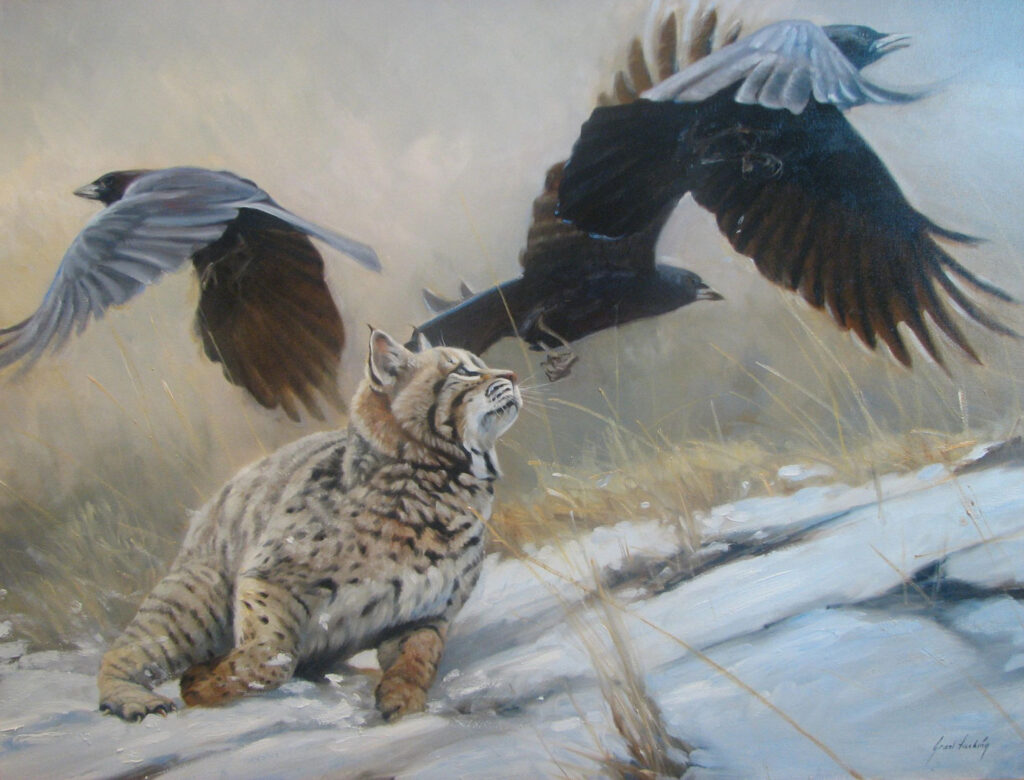
Grant Hacking
South African and American, born 1964
Thrill Seeker—Bobcat and Crows
2007
Oil on canvas
Art Spotlight
By: Emily Kapes | Curator of Art
In 2007, South African-born artist Grant Hacking was juggling his small children, a mortgage, a painting career and all the trappings of a good life based in New Hampshire. But feeling overwhelmed one day, he realized that everything was running him and not the other way around. He decided to take control by hiring a life coach to get organized and healthy. He also took his first major trip out West for painting inspiration. He had lived in the U.S. for 16 years but had neglected seeing much of the country. It was a life-changing experience to explore the mountainous scenery and observe wildlife.
Upon his return home with a new perspective, Hacking became more intentional and focused with his art, and his career began to flourish. He painted Thrill Seeker—Bobcat and Crows in the months after the trip, and he sees it as one of the strongest paintings of his career so far. The painting is personal and symbolic of his life at the time. The three crows symbolize three major issues in his life. They are being banished by the bobcat, which is turning in a strong and fast motion. Upon first glance, it is natural to assume the bobcat is trying to catch the crows; hearing directly from the artist about his inspiration adds a different perspective to the story.
The focus of the painting is the cat’s face. Hacking draws your eye to it by depicting it with much more detail than the rest of the painting, its eyes locked onto the crows. Moving away from the center, painting details begin to soften and the loose brushwork in the snow and flapping wings help to convey the action in this overcast, winter scene. Also, the composition of the crows and bobcat form a “V” shape, with the cat’s face right in the middle.
Though the bobcat is pushing off the snowy ground to pounce, it’s clear the crows—and Hacking’s troubles—have been driven off for good.
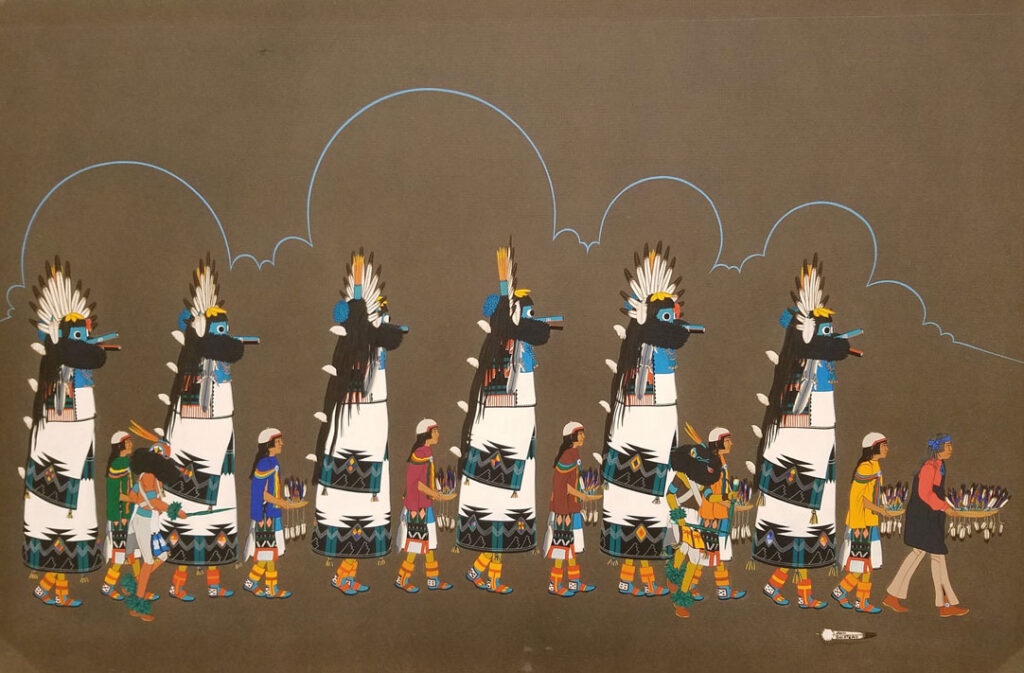
Johnny Secatero
Navajo (Diné) 1945–2010
Shalako Procession
Not dated
Acrylic on paperboard
Art Spotlight
By: Jason Wyatt | Collections Manager
Navajo artist Johnny Secatero has captured a tableau from the Zuni Shalako Ceremony that takes place in December at dusk, coinciding with a full moon and the winter solstice. The ceremony marks the end of a yearlong series of ritual festivals. Led by a medicine man, the tall figures are six dancers dressed as Shalakos, the messengers between the Zuni people and their gods. Each dancer wears a cagelike structure that can reach a height of over 9 feet. The structure is covered with elaborately woven and embroidered blankets to hide the dancer and to create the illusion that the true spiritual Shalakos are present. The crest of the mask is made up of black and white eagle feathers, while the ruffle around its base is made with black raven feathers. A mechanism within the structure gives the dancer the ability to move the protruding eyes and clap its beak. The adults know that the dancing figures are representations, but young children see these mechanics as being the real Shalakos, instilling a ritual belief they will carry with them throughout their lives.
Accompanying the Shalakos are attendants who will be asked throughout the ceremony to step in for the dancers. The distinctive swooping motion and manipulations of the mask are difficult to do for a long time, and the principle dancers may need to take a break. Also depicted are two dancers dressed to represent the physical embodiment of the Salimopiya, who serve as the protectors of the Shalakos. They each wear a mask that is mostly obscured by thick collars of black crow feathers. The Salimopiya carry yucca whips in each hand to purify any Zuni who has had bad dreams or bad luck throughout the year. Tied into the whips are seeds being ritually strengthened in preparation for a spring planting.
This painting depicts the final moments of an elaborate ceremony to say goodbye to the old while welcoming in the new that takes place over a 24-hour period. The physical manifestations of many of the Zuni gods visit the pueblo to give blessings, feast and dance with the mortals. This is also a time when the spirits of all the ancestors visit the pueblo, are given offerings and asked to help the Shalakos bring the prayers to the gods for rain, long life and peace. The ceremony ends the following day with the processional departure of the gods from the pueblo. The last to leave are the Shalakos.
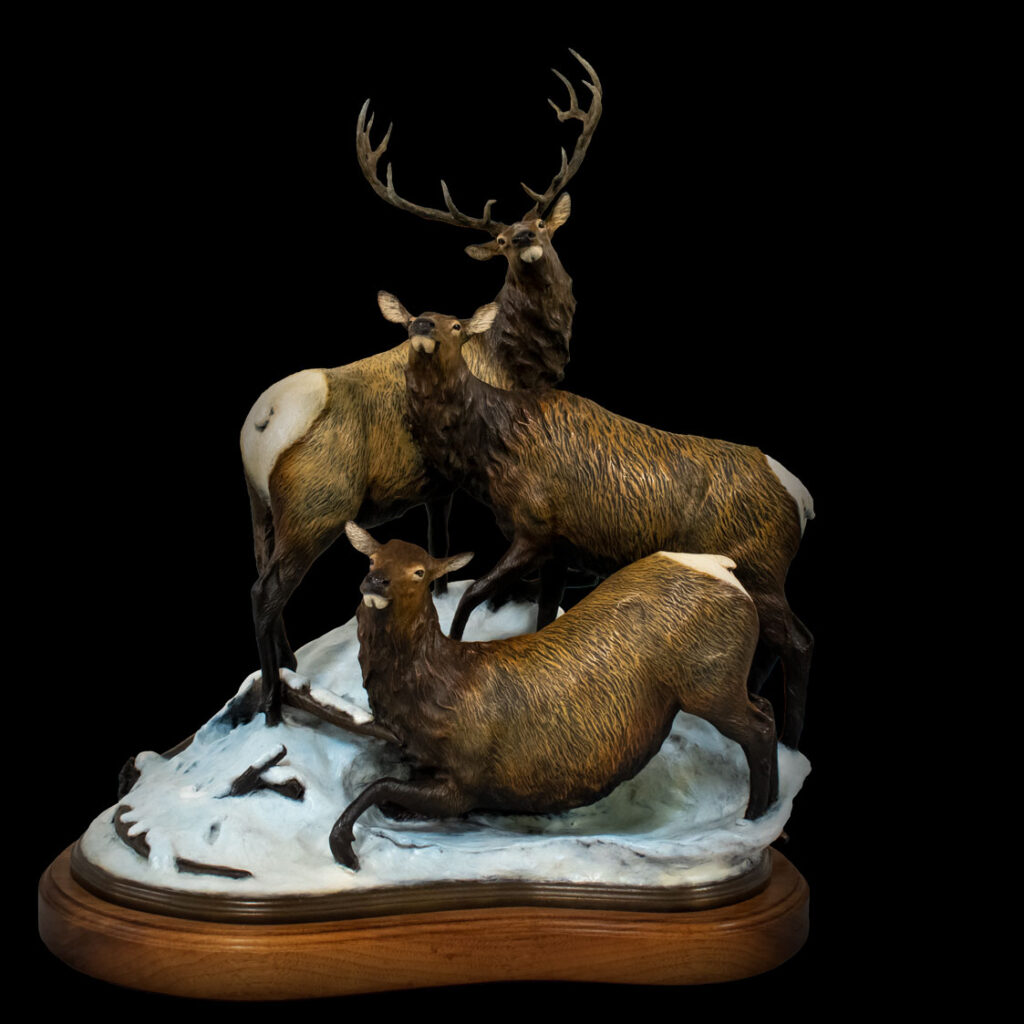
Sam Terakedis
American, 20th century
Moving Out
2000
Bronze
Art Spotlight
By: Jason Wyatt | Collections Manager
In this sculpture, self-taught artist Sam Terakedis presents a male elk with fully developed antlers standing with two females in fresh snow. The testosterone levels in male elk begin to drop once the breeding season ends in late fall, causing the males to shed their antlers in early winter. The elk’s coat also thickens during the fall in preparation for the cold winter temperatures. The artist clearly creates thick manes around the necks of all three of the elk in this sculpture, a true sign that winter is approaching.
The title of the sculpture, Moving Out, alludes to the fact that these elk are beginning the winter migration for more readily available food. The main diet of elk is grass, which can be hard to digest, so their migration patterns are based on locating the easier-to-digest younger green blades. In winter, they come down from the mountains to feed in valleys that have less snow cover. In summer, the herd will travel back up into the mountains to take advantage of the younger grasses there.
Recent studies have shown that many of the migration paths for elk have been blocked by land development in the form of tall fences and subdivisions built on former ranch land. Energy development, like drilling for natural gas and the construction of windmill farms, also has disrupted migration patterns. These disruptions affect the health of the herds, which in turn disrupts the ecosystem because elk are an important factor in the survival of many other species. Not only are the grazing habits of elk important for the balance of the ecosystem, but elk are also a food source for other animals such as grizzly bears, wolves, mountain lions and scavengers. Without healthy elk herds, the ecosystem of North America can be thrown off balance, thereby causing irreparable harm to the environment. In 2018 the Secretary of the Interior began directing more resources toward the protection of migration routes for elk and other big game.
Books
The James Museum Book Club Recommends…
Ada Blackjack: A True Story of Survival in the Arctic
By Jennifer Niven
This is the fascinating story of an Arctic expedition gone wrong in 1921-23. Ada Blackjack, a young Inupiaq/Eskimo woman, is hired to sew and cook for four men who set out to establish a settlement on desolate Wrangel Island, 300 miles above the Arctic Circle. They have only six months of supplies and must live off the land for the rest, expecting a supply ship the next summer. It never comes. At the end of two years, Ada and their cat are the only survivors.
The four men are interesting characters depicted through quotations from letters, notes, and journals they and their families wrote. Although she was barely literate, Ada also kept a journal at the end of the expedition. In addition, Niven mined government and press reports from the time and interviewed many people, including Ada’s son.
Even though you know how the expedition ends, it is a gripping story with life and death hanging in the balance at many turns. It will make you glad you are reading in the safety and comfort of your own home with grocery stores nearby and no polar bears sniffing around outside for food. Reading about the ravages of scurvy, which afflicted one of the men, prompted me to go out and buy a bag of oranges.
Two controversial men who played major roles in determining the fate of the expedition were explorer Vilhjalmur Stefansson who organized it and believed in the “friendly Arctic,” and Harold Noice, who led the rescue expedition. Both were more interested in their own finances and reputations than the welfare of the group on Wrangel. Today Wrangel Island is a nature preserve owned by Russia.
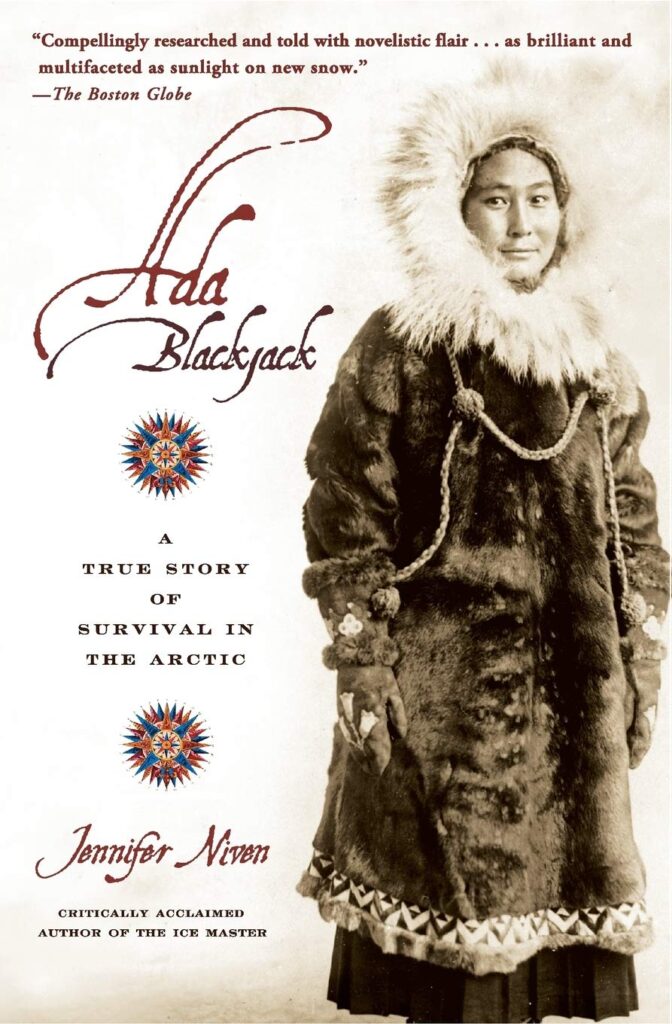

Helen Huntley
Book Club Discussion Leader
Ada Blackjack Rising
Short film based on the book
In the pre-dawn twilight of an Alaskan shore, a young Native woman reflects on the story of Ada Blackjack, the sole survivor of a disastrous 1921 Arctic expedition, and the loneliness she must have felt waiting for a rescue through the months-long polar night. 6:30 min.
Movies
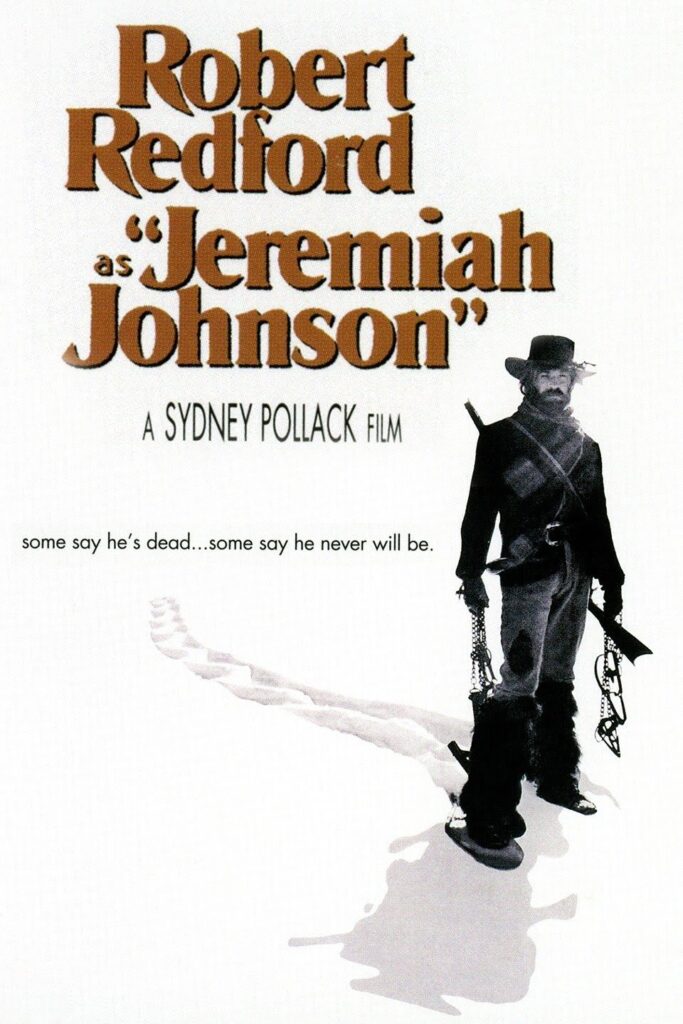
Jeremiah Johnson (1972)
Set against the sublime backdrop of Utah’s Wasatch Mountain Range, Jeremiah Johnson follows a Mexican-American War veteran’s journey to forget his past and find rebirth in the mountains. Motivated by fantasies of rugged hermitage, Johnson quickly overcomes his wilderness ineptitude and, with the help of an unsentimental bear trapper, a native woman, and an adopted son, navigates the complexities of survival and the precarious relationship between early frontiersmen and native peoples. Rated PG; 108 minutes.
The Grizzlies (2018)
Based on an inspiring true story, this movie is set in the Canadian hamlet of Kugluktuk, located north of the Arctic Circle. It follows a group of teens, transformed by the power of sport, family, tradition, and community, who in turn transformed their town, with the highest suicide rate in North America, into a model of hope and youth-led resilience. The students are initially resistant when the naive and culturally ignorant white teacher from the south introduces them to lacrosse. Gradually, as they begin to connect with each other as teammates, the students find inspiration to make profound shifts in their lives. Rated R; 106 minutes.
